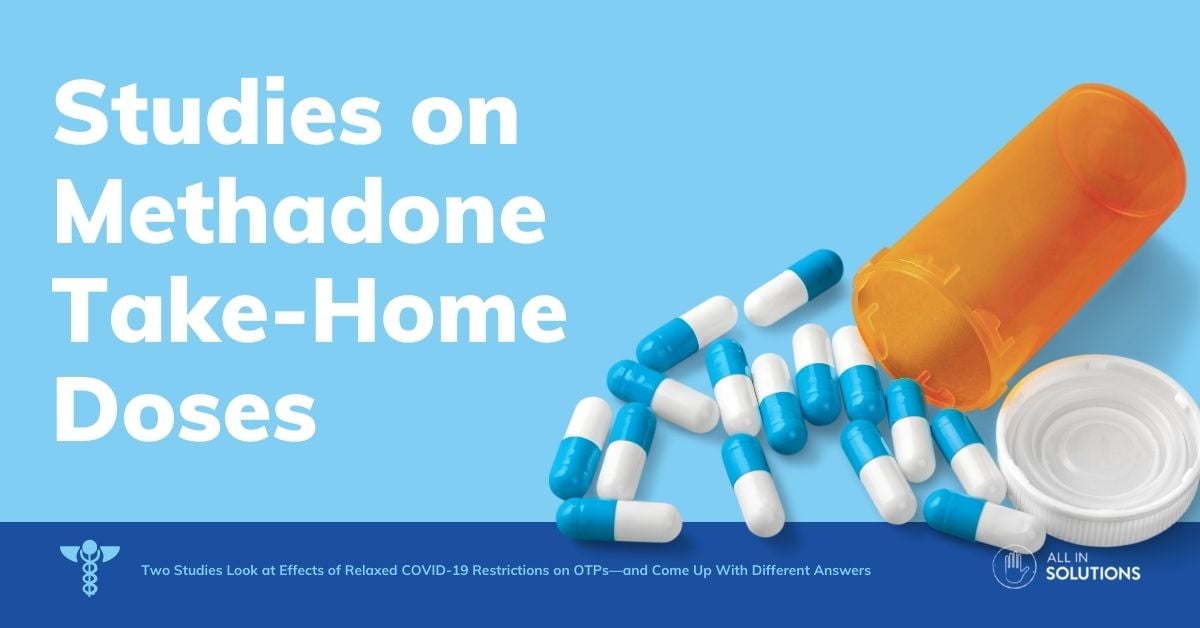Two Studies Look at Effects of Relaxed COVID-19 Restrictions on OTPs—and Come Up With Different Answers
Thu, 13 Jan 2022 21:09:53 +0000
This article originally appeared on:
atforum.com/2022/01/studies-covid-19-restrictions-otps/
“No Home to Take Methadone to,” a story recently published on this website, investigated the effects of relaxed COVID-19 restrictions on opioid treatment programs (OTPs). That story shows it’s essential to listen to what patients, not just providers, say about patients’ treatment experiences. It also shows that most participants found their experience with addiction service access as “destabilizing” or “unjust.”
Discussed below is a new article that looks at the same topic, and listens to patients—yet finds that patients’ opinions were generally favorable—a marked difference from patients’ opinions gleaned in the first study.
The New Study
Selected as participants in the new study were 46 patients with opioid use disorder (OUD) enrolled at three rural OTPs in Oregon. The patients were English-speaking adults receiving varying OTP take-home doses of methadone, in accordance with COVID-19-related policy changes. (See box.)
Methadone Take-Homes: one third of participants got one take home dose per week, one fourth got 2 to 6 take home doses per week, one fifth got 13 doses per 2 weeks, and one fifth got 27 doses per month.
Individual qualitative interviews took place by phone, in two phases: August–October 2020 and November 2020–January 2021. Trained interviewers conducted all interviews, which were professionally recorded and transcribed. The average interview lasted 33 minutes.
Patients answered questions on COVID-10-related changes to methadone take-home dosing and OTP procedures, benefits and challenges involving take-home methadone, safety concerns involving infection and overdose, and policy considerations for post-pandemic assessment.
Patient Characteristics
About 80% of participants had some education beyond high school level. Only 7% had been homeless at some point during the previous 6 months. 96% identified themselves as Caucasian/White
Participants described some fears and anxieties involving ongoing methadone access. Many also had safety concerns that preceded the policy changes. Yet participants quickly adapted to the changes, because the protocols soon seemed “natural” to them.
Most participants acknowledged substantial benefits to increased take-homes. The benefits were independent of reducing COVID-19 infection risk, and included feeling more like a normal person.” Specific benefits cited were improved recovery support, less time spent traveling, and more time available for family and work.
Looking to a post-pandemic future, participants thought that continuing some COVID-19-related safety protocols would reduce risk of other infections, reduce stress at OTPs, and lead to patient care that would be more individualized.
Adapting to Changing OTP Policies: Participants’ Comments
Participants noticed that policy changes were quickly implemented. Some comments:
“One day it was like boom. Everything changed … but [providers] didn’t over-react. They didn’t panic…
Extensive safety precautions were rapidly rolled out … and participants adhered, keeping themselves and others safe
Sometimes you don’t want to wear a mask, it’s suffocating… [but if] we want to be safe and not catch [COVID], then that’s it.
Policies like mask-wearing soon seemed routine.
Now everybody is kind of used to it.”
Some participants said that take-home dosing and less frequent OTP visits gave them a feeling of stability. Some commented that having more take-homes provided a feeling of pride.
“… you feel you are being trusted to take care of yourself, and do the right thing…it felt great…that I was on the right track in my recovery”
It also helped participants avoid unstable patients. Seeing people “nodding out” could, some said, trigger a desire to “go get high.”
Many put to good use the money and time they’d previously spent for daily visits.
“It gives me a little break
[No need to] arrange childcare.”
Social distancing reduces confrontations and creates “a more supportive environment for recovery and mental health”
… too many people in the waiting room… triggers anxiety
People see other people they have a problem with, so “a lot of fights seem to happen”
A few participants mentioned challenges, such as temptation.
Some people don’t trust themselves.
As for continuing the new protocols post-pandemic, some participants felt that doing so would help prevent other infections.
Overall, most participants quickly adapted to the protocols. They had little difficulty managing take-homes, using lockboxes, and dosing as instructed.
Suggestions for Improvements
The authors offered several ideas.
Policymakers could give more thought to criteria for assessing patient stability“Technology-assisted dosing via tele-monitoring,” automated home medication dispensers, and home delivery of methadone could be consideredAnother possibility: office-based methadone; “Pilot studies transferring stable patients from OTPs to primary care settings for ongoing methadone have been successful”
The authors noted that the insights and benefits their study revealed “should inform future policy development post-pandemic to better address the ongoing overdose epidemic.”
Similar Studies… Why Different Findings?
As the pandemic progressed, participants in the current study adapted to rapidly changing OTP policies. They noted many benefits to increased take-homes and other COVID-19 protocols—including some benefits they hadn’t anticipated, such as strengthened self-efficacy and recovery, and reduced interpersonal conflict. Their overall response to the changing policies was positive.
These findings clearly differ from those of the earlier study, “No Home to Take Methadone to.” Participants in the earlier study broadly described experiences with addiction service access during the pandemic as: “Liberating” – 7 participants; “Destabilizing” – 8; “Unjust” – 5.
So only about one-third of the study group had a positive response.
What’s behind the differences in patients’ responses in the two studies? We invited the lead author of each study to comment. Dr. Levander’s response, directly below, is followed by Dr. Harris’ response.
Dr. Levander:
Our assessment, after further review of both studies, is that the findings are more similar and complementary than different and conflicting. The differences in the papers reflect different samples and research questions.
Our study, the Oregon analysis, specifically focused on interviewing individuals in care in three OTPs that served rural counties. Study participants were, for the most part, stable OTP participants, and many had been in care for months to years. The interviews focused on how the relaxation of the take-home methadone restrictions affected their care.
The Boston study differed substantially. Participants were drawn from individuals who had a history of opioid overdose, and were being treated in an emergency department in an urban setting. Also, to help prevent future overdoses, intervention was supported with medications for opioid use disorder. Participants apparently were new to care, and their condition was relatively unstable.
Note that 50% of the eligible sample were not located, and were, we assume, not in care. The questions were not specific to only the take-home relaxations. The six topics were broad questions about their response to the pandemic and access to all types of substance use disorder treatment and harm-reduction services.
Our Oregon sample broadly reflected the same perspectives as the Boston participants who felt the policy changes were liberating; they had more access to take-homes, and, as a result, less travel time to and from the OTP. Individuals who were newer to care and receiving fewer take-homes sometimes expressed concerns like those the Boston participants characterized as “destabilizing”—the value of the OTP structure and in-person support.
Both studies concluded with the importance of delivering patient-centered care for substance use disorder. This requires centering on the voices and needs of patients when developing, implementing, and evaluating programs and policies.
Ximena Levander, MD, MCR
Dr. Levander is an assistant professor of medicine at the Oregon Health & Science University, with a special focus on addiction medicine.
§ § §
Dr. Harris agreed with many of Dr. Levander’s comments. Here are her remarks:
Dr. Harris:
Our study populations were very different. Our population included people with a history of overdose, some of whom had long-term connections with OTPs and buprenorphine, but 30% of whom were not on any form of medication for opioid use disorder [MOUD]. Only 50% of participants were in methadone programs, and some of these participants had recently started methadone treatment in our study.
Additionally, and I believe most importantly, only 6% of Dr. Levander’s study participants were unhoused in the past six months, compared to 40% in our study. An additional 15% were in some form of residential housing in our study as well, reflecting a degree of housing insecurity. This is a large difference in terms of the level of structural marginalization our study participants were experiencing.
Participants in the Boston study faced with this level of structural marginalization did not stand to benefit from the relaxed restrictions in the unjust group, because their lack of housing and other social supports precluded them from being given the opportunity for take-homes or engaging in tele-therapy/MOUD. Therefore, it is not that these participants had “negative” experiences per se with the relaxed restrictions, they were simply excluded, and this was perceived as unjust.
For those who felt changes were destabilizing, this group too were either mostly unhoused or recently housed. Part of the destabilizing experiences may have been related to not attending an OTP daily, but were also related to fractures with their community supports with the shutting of in-person services, such as counselor services at the methadone clinics, and the closure of syringe service programs physical spaces that had been places for community gathering and connection.
Therefore, our conclusion stands and is greatly supported by Dr. Levander’s findings, liberalizations to methadone and tele-buprenorphine offer an opportunity for greater patient-centered care in the US, which we know is associated with better outcomes.
However, for benefits to be equitably experienced, we must reduce structural marginalization faced by those using these services. Namely, increase access to low-barrier housing for people with an opioid use disorder, and ensure methadone clinic hours are expanded and transportation is provided for those who need it to increase access and flexibility.
Miriam Harris, MD, MSc
Dr. Harris is an assistant professor of medicine at Boston University School of Medicine, and an addiction expert at Boston Medical Center.
Reference
Levander XA, Hoffman KA, McIlveen JW, McCarty D, Terashima JP, Korthuis PT. Rural opioid treatment program patient perspectives on take-home methadone policy changes during COVID-19: a qualitative thematic analysis. Addict Sci Clin Pract. 2021;16(1):72. Published 2021 Dec 11. doi:10.1186/s13722-021-00281-3
The Previous Study
Harris MTH, Lambert AM, Maschke AD, Bagley SM, Walley AY, Gunn CM. “No home to take methadone to”: Experiences with addiction services during the COVID-19 pandemic among survivors of opioid overdose in Boston [published online ahead of print, 2021 Nov 4]. J Subst Abuse Treat. 2021;108655. doi:10.1016/j.jsat.2021.108655
The post Two Studies Look at Effects of Relaxed COVID-19 Restrictions on OTPs—and Come Up With Different Answers appeared first on Addiction Treatment Forum.
All In Solutions Counseling Center is a network of addiction treatment providers. We outpatient and inpatient addiction treatment programs that are tailored to meet each client’s needs. Our specialized programs include:
- Faith-based rehab
- Medication assisted opioid treatment
- Art therapy treatment
- Men’s drug & alcohol rehab
- Women’s drug & alcohol rehab
Our locations include:
Did you miss our previous article…
https://www.allinsolutions.com/podcast-you-dont-need-the-lollipop-right-now/





